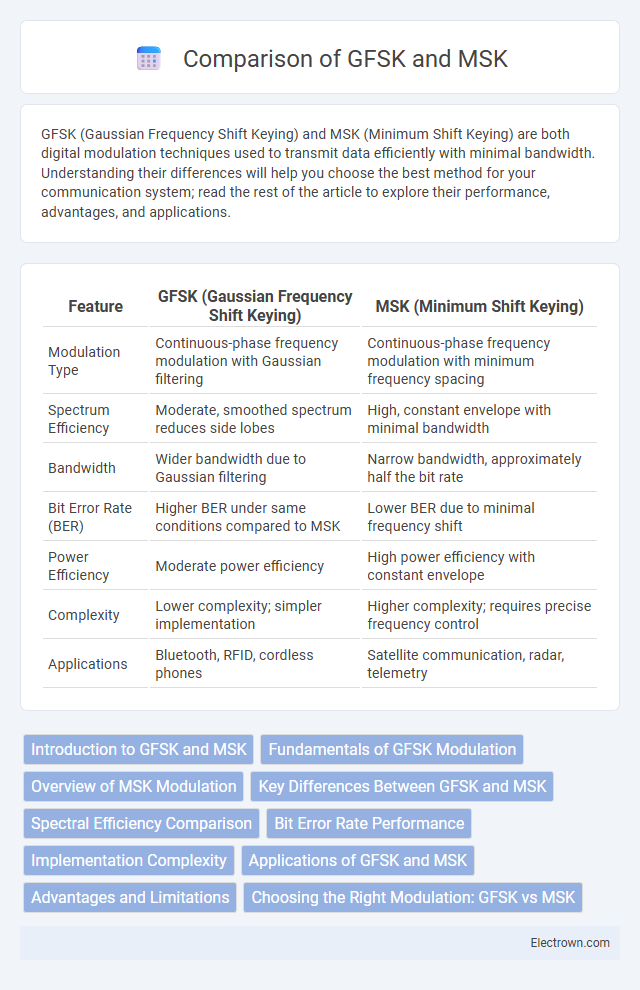GFSK (Gaussian Frequency Shift Keying) and MSK (Minimum Shift Keying) are both digital modulation techniques used to transmit data efficiently with minimal bandwidth. Understanding their differences will help you choose the best method for your communication system; read the rest of the article to explore their performance, advantages, and applications.
Table of Comparison
| Feature | GFSK (Gaussian Frequency Shift Keying) | MSK (Minimum Shift Keying) |
|---|---|---|
| Modulation Type | Continuous-phase frequency modulation with Gaussian filtering | Continuous-phase frequency modulation with minimum frequency spacing |
| Spectrum Efficiency | Moderate, smoothed spectrum reduces side lobes | High, constant envelope with minimal bandwidth |
| Bandwidth | Wider bandwidth due to Gaussian filtering | Narrow bandwidth, approximately half the bit rate |
| Bit Error Rate (BER) | Higher BER under same conditions compared to MSK | Lower BER due to minimal frequency shift |
| Power Efficiency | Moderate power efficiency | High power efficiency with constant envelope |
| Complexity | Lower complexity; simpler implementation | Higher complexity; requires precise frequency control |
| Applications | Bluetooth, RFID, cordless phones | Satellite communication, radar, telemetry |
Introduction to GFSK and MSK
GFSK (Gaussian Frequency Shift Keying) and MSK (Minimum Shift Keying) are digital modulation schemes widely used in wireless communication systems for efficient data transmission. GFSK applies a Gaussian filter to smooth frequency transitions, reducing bandwidth and minimizing interference, making it ideal for Bluetooth and other low-power applications. MSK, a type of continuous-phase frequency shift keying, provides constant envelope modulation with minimal frequency deviation, offering improved spectral efficiency and resilience against non-linear distortion in high-speed wireless links.
Fundamentals of GFSK Modulation
GFSK (Gaussian Frequency Shift Keying) modulation shapes the digital signal with a Gaussian filter before frequency modulation, reducing spectral bandwidth and inter-symbol interference. This technique smooths the frequency transitions, resulting in improved spectral efficiency and lower out-of-band emissions compared to traditional FSK. Understanding GFSK's filtering process helps optimize your wireless communication systems for reliable and power-efficient data transmission.
Overview of MSK Modulation
MSK (Minimum Shift Keying) is a type of continuous-phase frequency shift keying that offers improved spectral efficiency and constant envelope properties compared to GFSK (Gaussian Frequency Shift Keying). MSK minimizes phase discontinuities by using frequency shifts that are half the bit rate, resulting in a signal with reduced sideband power and less interference. Your communication system benefits from MSK's robustness in fading channels and its suitability for bandwidth-efficient digital transmissions.
Key Differences Between GFSK and MSK
GFSK (Gaussian Frequency Shift Keying) uses a Gaussian filter to smooth the frequency transitions, reducing bandwidth and adjacent channel interference, whereas MSK (Minimum Shift Keying) employs continuous phase modulation for constant envelope and minimized phase discontinuities. GFSK is commonly favored in Bluetooth and low-power wireless applications due to its spectral efficiency and simplicity, while MSK provides better error performance and robustness in fading channels, often utilized in satellite and military communications. Understanding these key differences helps optimize Your choice of modulation scheme based on system requirements such as bandwidth efficiency, power constraints, and channel conditions.
Spectral Efficiency Comparison
GFSK offers moderate spectral efficiency by shaping the frequency pulse to reduce side lobes, making it suitable for bandwidth-limited applications like Bluetooth. MSK provides higher spectral efficiency due to its continuous phase modulation and constant envelope, allowing more data transmission within the same bandwidth. Your choice between GFSK and MSK depends on the required balance between spectral efficiency and implementation complexity.
Bit Error Rate Performance
GFSK (Gaussian Frequency Shift Keying) typically exhibits higher bit error rate (BER) compared to MSK (Minimum Shift Keying) due to its non-constant envelope causing more susceptibility to noise and nonlinearities. MSK provides superior BER performance by maintaining phase continuity and a constant envelope, which enhances noise resilience and reduces intersymbol interference. In practical wireless communication systems, MSK's BER advantage is especially noticeable under low signal-to-noise ratio (SNR) conditions, making it preferable for reliable data transmission.
Implementation Complexity
GFSK (Gaussian Frequency Shift Keying) offers lower implementation complexity due to its simpler modulation and demodulation processes, making it suitable for low-power and resource-constrained devices. MSK (Minimum Shift Keying) employs a continuous phase modulation scheme with constant envelope properties, requiring more sophisticated signal processing techniques and accurate phase tracking, increasing implementation complexity. Your choice between GFSK and MSK depends on the balance between system complexity and performance requirements for your communication application.
Applications of GFSK and MSK
GFSK is widely used in short-range wireless communication systems such as Bluetooth and RFID due to its spectral efficiency and low power consumption. MSK finds applications in satellite communications and military telemetry where constant envelope modulation improves signal robustness. Both techniques support digital data transmission but cater to different operational environments based on their modulation characteristics.
Advantages and Limitations
GFSK (Gaussian Frequency Shift Keying) offers advantages such as reduced bandwidth and improved spectral efficiency due to its smooth Gaussian filter, making it ideal for low-power, wireless communication systems like Bluetooth. However, GFSK is more susceptible to frequency offset and phase noise than MSK (Minimum Shift Keying), which provides constant envelope modulation and better resilience to non-linear distortions. MSK's advantages include minimal spectral side lobes and superior bit error performance under AWGN conditions, but its more complex demodulation process limits its use in simple RF transceivers.
Choosing the Right Modulation: GFSK vs MSK
Choosing between GFSK and MSK modulation depends on your application's requirements for spectral efficiency and robustness to noise. GFSK (Gaussian Frequency Shift Keying) offers reduced bandwidth and improved spectral efficiency, making it ideal for wireless communication systems like Bluetooth. MSK (Minimum Shift Keying) provides constant envelope and better resilience to phase noise, suitable for high data rate applications requiring improved error performance.
GFSK vs MSK Infographic

 electrown.com
electrown.com